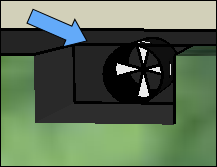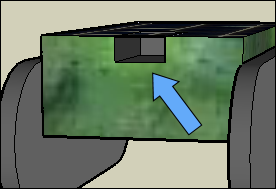 While eliminating monoculture and changing farming techniques will eliminate most insects on a farm and will do a great deal to decrease the need for pesticides, a few insects and pests will still exist on the farm. Accordingly, the robots should have a more active method of dealing with these pests. In order to further decrease the harm of insects and the need for pesticides, both the hunter robot and the master robot are equipped with a biomimicry box that will be used to attract and capture pests. The biomimicry box will contain a variety of pheromones that attract the most common pests and insects . Once inside the box, the insects will be unable to escape (See figures). Thus, while performing their normal tasks, the robots will also be fighting pests and insects, saving the crops and, perhaps more importantly, protecting the environment from the use of potentially dangerous pesticides.
While eliminating monoculture and changing farming techniques will eliminate most insects on a farm and will do a great deal to decrease the need for pesticides, a few insects and pests will still exist on the farm. Accordingly, the robots should have a more active method of dealing with these pests. In order to further decrease the harm of insects and the need for pesticides, both the hunter robot and the master robot are equipped with a biomimicry box that will be used to attract and capture pests. The biomimicry box will contain a variety of pheromones that attract the most common pests and insects . Once inside the box, the insects will be unable to escape (See figures). Thus, while performing their normal tasks, the robots will also be fighting pests and insects, saving the crops and, perhaps more importantly, protecting the environment from the use of potentially dangerous pesticides.
 In addition to mitigating harmful insects, the robots will also be able to assist in fending off plant disease. Once again, it is important to realize that by ending the practice of monoculture, most disease problems will disappear. But because the potential for disease still exists, the robots must be prepared. In order to fight diseases, the base lab will be able to perform the "TIGER", or Triangulation Identification for Genetic Evaluation of Risks, process. This process, as developed by the Agricultural Research Service, will inform farmers which plants are infected [9]. Further, TIGER, in tandem with the DNA samples, will allow the master robot to collect infected plants before disease can spread to other crops.
In addition to mitigating harmful insects, the robots will also be able to assist in fending off plant disease. Once again, it is important to realize that by ending the practice of monoculture, most disease problems will disappear. But because the potential for disease still exists, the robots must be prepared. In order to fight diseases, the base lab will be able to perform the "TIGER", or Triangulation Identification for Genetic Evaluation of Risks, process. This process, as developed by the Agricultural Research Service, will inform farmers which plants are infected [9]. Further, TIGER, in tandem with the DNA samples, will allow the master robot to collect infected plants before disease can spread to other crops.
 While eliminating monoculture and changing farming techniques will eliminate most insects on a farm and will do a great deal to decrease the need for pesticides, a few insects and pests will still exist on the farm. Accordingly, the robots should have a more active method of dealing with these pests. In order to further decrease the harm of insects and the need for pesticides, both the hunter robot and the master robot are equipped with a biomimicry box that will be used to attract and capture pests. The biomimicry box will contain a variety of pheromones that attract the most common pests and insects . Once inside the box, the insects will be unable to escape (See figures). Thus, while performing their normal tasks, the robots will also be fighting pests and insects, saving the crops and, perhaps more importantly, protecting the environment from the use of potentially dangerous pesticides.
While eliminating monoculture and changing farming techniques will eliminate most insects on a farm and will do a great deal to decrease the need for pesticides, a few insects and pests will still exist on the farm. Accordingly, the robots should have a more active method of dealing with these pests. In order to further decrease the harm of insects and the need for pesticides, both the hunter robot and the master robot are equipped with a biomimicry box that will be used to attract and capture pests. The biomimicry box will contain a variety of pheromones that attract the most common pests and insects . Once inside the box, the insects will be unable to escape (See figures). Thus, while performing their normal tasks, the robots will also be fighting pests and insects, saving the crops and, perhaps more importantly, protecting the environment from the use of potentially dangerous pesticides. In addition to mitigating harmful insects, the robots will also be able to assist in fending off plant disease. Once again, it is important to realize that by ending the practice of monoculture, most disease problems will disappear. But because the potential for disease still exists, the robots must be prepared. In order to fight diseases, the base lab will be able to perform the "TIGER", or Triangulation Identification for Genetic Evaluation of Risks, process. This process, as developed by the Agricultural Research Service, will inform farmers which plants are infected [9]. Further, TIGER, in tandem with the DNA samples, will allow the master robot to collect infected plants before disease can spread to other crops.
In addition to mitigating harmful insects, the robots will also be able to assist in fending off plant disease. Once again, it is important to realize that by ending the practice of monoculture, most disease problems will disappear. But because the potential for disease still exists, the robots must be prepared. In order to fight diseases, the base lab will be able to perform the "TIGER", or Triangulation Identification for Genetic Evaluation of Risks, process. This process, as developed by the Agricultural Research Service, will inform farmers which plants are infected [9]. Further, TIGER, in tandem with the DNA samples, will allow the master robot to collect infected plants before disease can spread to other crops.